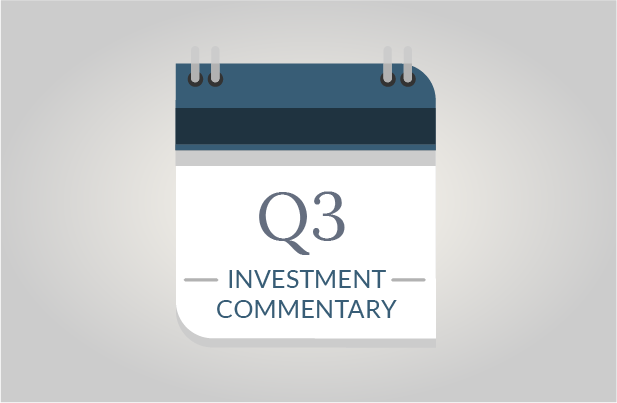- Stocks and bonds ascended.
- The Fed cut interest rates for the first time since driving rates higher in 2022.
- Significant reversals in stock market sector performance demonstrate the risk of chasing and timing the markets.
Strong Returns All Around
Healthy returns in virtually every sector of the markets rewarded investors during the third quarter. Both stocks and bonds posted strong results. Lower inflation, declining interest rates, the Fed’s first rate cut, and a healthy economy created the ideal environment for investments.
Interestingly, the third quarter also brought meaningful shifts in stock performance as small-cap and international stocks significantly outperformed the beloved S&P 500.
Throughout the year, many investors have worried about the impact of the upcoming U.S. elections and worldwide events on the investment markets. Thus far, any such concerns have failed to derail prosperous investment returns.
A summary of investment market returns as of September 30, 2024, is as follows:
Bloomberg U.S. Aggregate (U.S. bonds) 4.45%
S&P 500 Index (large U.S. stocks) 22.08%
Russell 2000 (small U.S. stocks) 11.17%
MSCI All Country World Index ex-US 14.21%
(International Stocks)
The Fed’s First Rate Cut
The third quarter’s investment momentum was largely driven by the expectation (and almost certainty) of the Fed’s first rate cut since it initiated steep rate increases in March 2022. The most recent inflation rate over the prior 12 months was reported at 2.5%.
The Fed’s decision of when to lower interest rates is a tricky one. If it acts too soon, inflation could spike again. However, lowering rates too late could send the economy into a recession. It is unknown how the decision to delay a rate cut for so long will impact the economy. Currently, the employment reports suggest that the economy remains healthy.
Early Moves in Interest Rates During the Third Quarter
People often assume that declines in market interest rates coincide with the Fed lowering rates. However, interest rates often move in advance of the Fed’s actions due to forward-looking expectations. This was clearly demonstrated in recent months. The 10-year Treasury yield fell by almost 19% from July 1st to September 17th, the day before the Fed lowered interest rates. This preemptive decline in rates benefited individuals, companies and investors.
Small-Cap Stocks Take Center Stage
Small-cap stocks have lagged behind their large-cap rivals for some time, but this trend has reversed in recent months. In fact, small-cap stocks posted returns that virtually doubled those of the S&P 500 in the third quarter.
Small-cap stocks are large benefactors of lower interest rates for two material reasons. Smaller companies are more reliant on loans to fund business growth initiatives. High interest rates in recent years have made borrowing too expensive for many small businesses. As a double whammy, smaller companies often have to borrow from local banks that frequently charge higher rates compared to larger banks. Now that interest rates are falling, loans are becoming more affordable, thereby poising small companies for a resurgence in growth.
A Surge in International Stock Returns
International stocks also outperformed the S&P 500 in the third quarter, reversing extended underperformance. Again, this shift was largely attributable to lower interest rates.
International stocks have long been viewed as being undervalued. Their average price-to-earnings ratio (P/E ratio) is markedly lower than the S&P 500’s P/E ratio. Additionally, their dividend yields are more than double that of the S&P 500, adding to investor returns. The primary obstacle to their performance has been a strong U.S. Dollar. When the U.S. Dollar is strong, it dilutes the value of international investments and their returns.
The ability for international stocks to overcome the impact of a strong U.S. Dollar was exacerbated in 2022. This is when the Fed started aggressive interest rate hikes. Higher interest rates attracted large investor inflows from other countries and drove the U.S. Dollar higher. Now, a reversal is happening. Monies are flowing out of the U.S. as the Fed cuts interest rates. These outflows contributed to almost a 5% decline in the U.S. Dollar during the third quarter.
Mortgage Rates & The Housing Market
One area that hasn’t felt the positive impact of declining interest rates is the housing market. 30-Year mortgage rates have fallen from above 7% into the 6% range, making borrowing costs more affordable. However, we continue to see weakness in home sales.
The most recent home sales data reflected a 2.5% decline in August, and a 4.2% decline from last August 2023. While housing prices remain incredibly high, the economic benefits of home transactions are dramatically lower than during Covid when home sales boomed.
U.S. Elections
We will move onto the hot investor topic of the upcoming U.S. elections. This is by far the most prevalent question we are receiving. As always, we will begin by saying that past returns are never indicative of future results. This said, we offer the following comments and observations.
Historical Election Years: We looked at stock market performance in election years dating back to the early 1900s. Stocks posted positive results in the majority of election years over this timeframe.
Year-to-Date Performance: We frequently hear comments that this year’s election is different from those of the past. If this is a widespread opinion, it has not spooked the markets. Stocks have been on a largely consistent upward trend since the beginning of the year.
Historical Presidential Administration Investment Results: Part of recent questions about the elections is which Presidential candidate would be better for stocks. Despite many opinions, there is no true answer. Again, looking back to the early 1900s, the markets have had both up and down years during every presidential administration. Additionally, stocks posted positive returns during the vast majority of full administrations of both parties. Hence, there is no one sure winner when it comes to investments.
Possible Market Headwinds Under Both Presidential Administrations: Another common question relates to inflation. Both candidates could push inflation higher. The most likely catalyst under a Harris administration is higher government spending. Under a Trump administration, possible trade wars could drive prices higher. We don’t see a solid answer as to which administration is best for inflation or investment returns.
Looking Forward
The discussion points above and recent performance in 2024 support a key belief in our investment approach: never time or chase the markets. Reversals in stock sector performance demonstrate that chasing the past winners can lead to investing in the future laggards. Additionally, predicting things like volatility due to politics can be proven wrong, such as thus far in 2024. We believe in developing well-rounded portfolios that align with your personal investment needs, goals, and investment preferences. As always, please contact us with any questions.
SageVest Wealth Management




